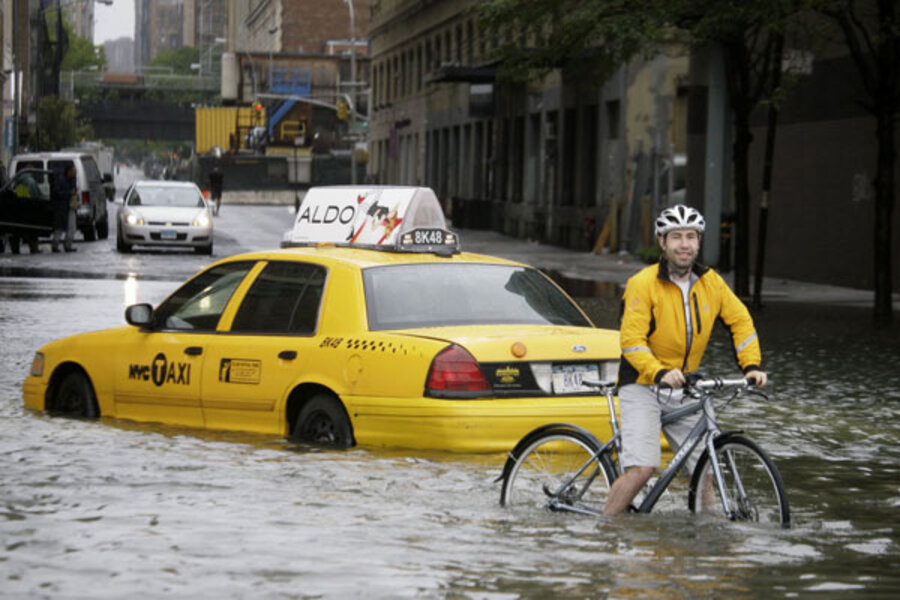Sea level studies: US coasts even more vulnerable than previously thought
Loading...
Cities and hamlets along America's popular coastlines are more vulnerable to rising sea levels than previously estimated, according to a pair of new studies.
The studies find up to 32 percent more coastal real estate vulnerable to a 1 meter rise in sea level, while the population exposed to rising water goes up by 87 percent.
The numbers vary markedly by region, with south Florida, southern Louisiana, and the Carolinas topping the list of states with the most land to lose. Populations would be most heavily affected in Florida, Louisiana, California, New York, and New Jersey, the studies find.
Since the 1880s, sea levels have risen an average of 8 inches as global warming has taken hold. During this century, levels are expected to rise by as much as 1 to 2 meters, depending on how much additional carbon dioxide humans pump into the atmosphere from burning fossil fuels and from land-use changes. The figure could be higher still, some researchers argue, if ice sheets atop Greenland and West Antarctica lose ice faster than currently anticipated.
Overall, 3.7 million people live at or below the 1-meter level, the studies find. Florida alone hosts an estimated $30 billion worth of taxable property along its vulnerable southeast coast, hinting at the enormous cost if global warming drives sea levels to conditions projected by the end of the century.
Between now and the end of the century, sea-level increases that fall considerably below 1 to 2 meters still pose interim threats, the studies hold. Between now and 2030, the likelihood of experiencing a once-in-a-century coastal flood will have more than doubled for at least two-thirds of the locations the studies cover. More than half of the locations could expect to see the likelihood of a once-per-century coastal flood triple.
“The risks are imminent and serious,” said Ben Strauss, a scientist with Climate Central and the lead author of one of two related papers appearing in the journal Environmental Research Letters, in a prepared statement.
Researchers from the University of Arizona and the National Oceanic and Atmospheric Administration also participated in the studies. Climate Central is a nonprofit climate-science and policy center based in Princeton, N.J.
The studies purport to be the first major overhaul in sea-level-rise estimates in 20 years and is the first to look at the increased risk to land, people, and infrastructure in its conclusions.
The increased estimates of vulnerability trace to better estimates of tide heights all along the coasts, rather than at select spots. These tide data reveal local high tides that can differ from one another by tens of feet.
Moreover, the worst flooding from storm surges can occur when a storm strikes at high tide. This led the team to use an area's average high-tide mark as the waterline, rather than a uniform 1 meter rise above average sea level all along the coastlines. In addition, land-elevation measurements have become more precise.
The studies appear at a time when several states are developing adaptation plans to deal with rising sea levels. In December 2010, for instance, New York State's task force on sea-level rise issued its final report and recommendations, which included identifying areas of highest risk and beginning to develop ways to reduce that risk. Recommendations also focused on updating maps and other data needed to monitor changes in risk to coastal communities.
Over the past several years, California and local governments in southeastern Florida also have begun to assess their options for coping with sea-level rise.
Yet the most vulnerable land remains among the most popular for development. In 2009, researchers with the US Environmental Protection Agency, the Woods Hole Oceanographic Institution, and several regional planning agencies reviewed development plans for communities up and down the East Coast. Nearly 60 percent of coastal lands lower than 1 meter above sea level have been slated for some form of development. Less than 1 percent of the land has been earmarked for conservation.
In addition to building on vulnerable lands, such projects also would prevent wetlands from migrating inland as sea levels rise. Wetlands not only serve as nurseries for marine life – an economic asset – but they also serve as buffers against storm surge.







